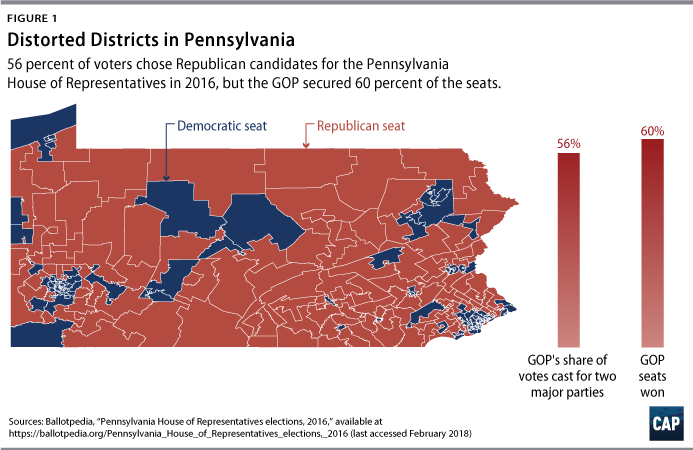The principle of “one person, one vote” requires states to redraw their election districts every 10 years in order to account for changes in population.1 In most states, legislators can manipulate district boundaries to benefit their own political party.2 This manipulation, called gerrymandering, weakens voters’ ability to affect election outcomes and exercise accountability over their government. Distorted election districts deny voters fair representation and lead to legislators who are less responsive to the will of the voters.
In January 2018, the Pennsylvania State Supreme Court found that the partisan gerrymandered congressional map drawn after the 2010 census violated the state constitution, whose Free and Equal Elections Clause guards against such “artificially entrench[ed] representative power.”3 In fact, Pennsylvania has the most skewed partisan congressional districts of any state.4 As a result, the Court ordered new maps to be drawn in time for the 2018 general election, and the Supreme Court of the United States has not blocked that decision.5 State legislative districts have also been distorted by partisan gerrymandering. Despite President Donald Trump only winning 48.2 percent of the Pennsylvania vote in 2016, Republicans maintained control of 59 percent of seats in the state House of Representatives and 68 percent of seats in the state Senate.6 Because legislators are shielded from accountability to their voters, a variety of policies supported by voters have failed to be enacted.
Gun violence prevention: A majority of Pennsylvania voters support stricter gun control laws and an even larger majority, 95 percent, support a requirement for universal background checks.7 Yet instead, the state Senate passed a law allowing teachers to carry firearms on school grounds.8
Civil rights: While 78 percent of Pennsylvanians support the passage of a nondiscrimination law on the basis of sexual orientation and gender identity,9 the state Legislature has refused to pass the Pennsylvania Fairness Act despite its reintroduction every year.10
Minimum wage: In 2016, a poll found that 76 percent of voters in Pennsylvania support an increase in the minimum wage.11 Despite strong public support for the increase, the legislative majority obstructed any legislative action, maintaining the wage of $7.25 per hour.12
Tax fairness: Of all the natural gas producing states in the country, Pennsylvania is the only one that does not impose a severance tax on gas companies. Seventy percent of voters would like to see the tax imposed, yet the Legislature has refused to pass it.13
